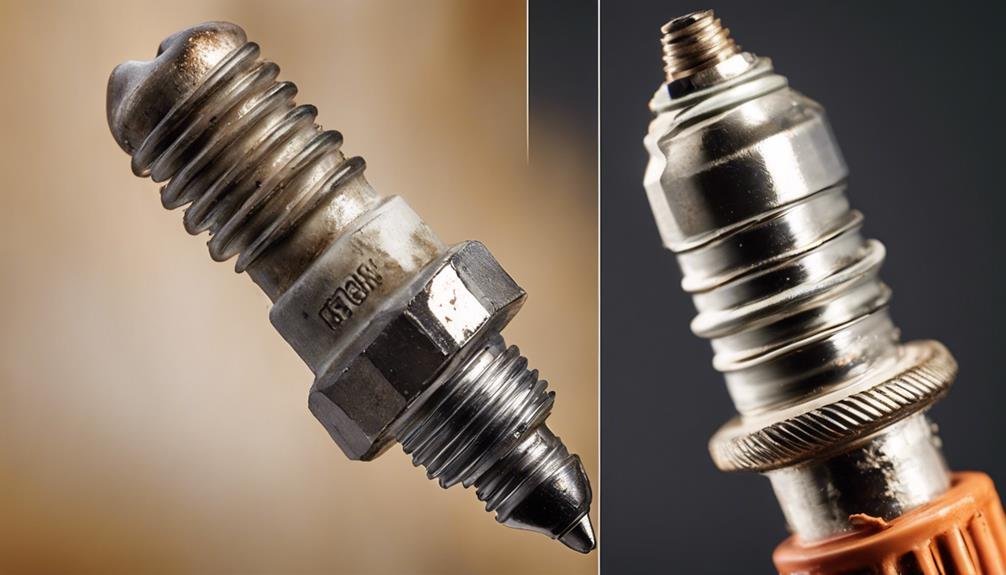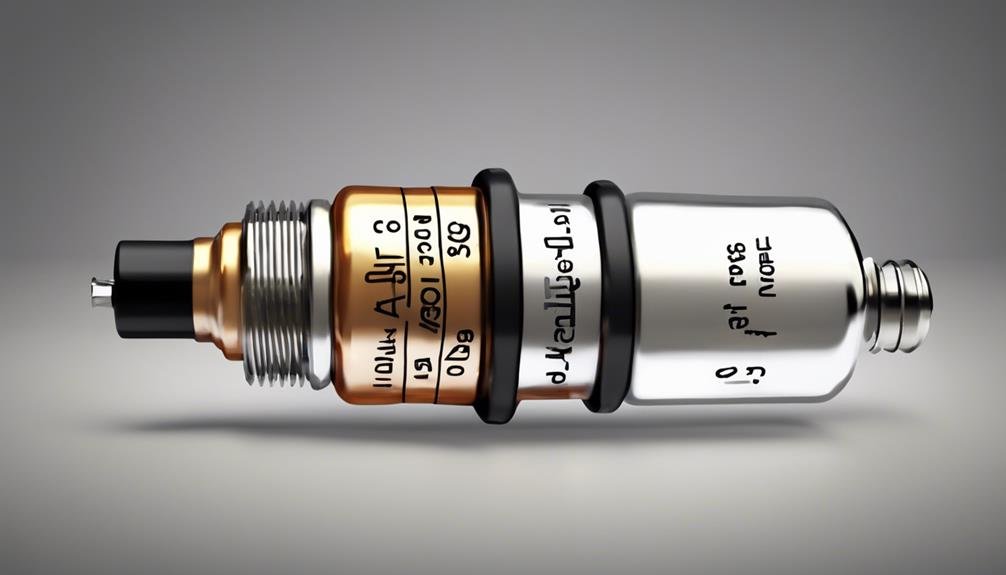When you pull a spark plug, it can reveal important info about your engine's performance. The plug's color can indicate fuel mixtures, ignition timing, and signs of overheating or wear. A brown or light gray color indicates good condition, while black deposits suggest a rich fuel mixture and white porcelain indicates a lean mixture. Fouling, deposits, and overheating can also be identified. By learning to interpret these signs, you can diagnose and fix problems holding your engine back. As you investigate the intricacies of spark plug analysis, you'll uncover more clues to optimize your engine's performance, and the story your spark plug tells will become clearer.
Key Takeaways
- A brown or light gray spark plug color indicates a healthy plug and proper engine operation.
- Black deposits on the spark plug suggest a rich fuel mixture, while a white porcelain insulator indicates a lean mixture.
- A glazed or glossy appearance on the spark plug indicates overheating, which can affect engine performance.
- Yellowish brown deposits on the spark plug are a sign of lead fouling, while dry, black carbon deposits indicate a rich fuel mixture.
- Spark plug condition can provide insight into ignition timing, with proper timing crucial to avoid pre-ignition issues and optimize engine performance.
Understanding Spark Plug Colors
When you analyze the spark plug colors, you'll quickly realize that they can disclose a wealth of information about your engine's performance. The colors of your spark plugs can indicate whether your engine is running efficiently or not.
A brown or light gray color indicates that your spark plugs are in good condition and functioning at their best. However, if you notice black deposits on your spark plugs, it may indicate a rich fuel mixture, which can potentially reduce horsepower. On the other hand, a white porcelain insulator suggests a lean fuel mixture, which can lead to engine issues.
The color of your spark plugs can also provide insights into your ignition timing. By reading the spark plug colors, you can adjust your ignition timing to achieve peak torque and horsepower. Proper timing adjustments are crucial to make sure your engine is running at its peak.
Identifying Fouling and Deposits
By examining the spark plug's firing end, you can identify fouling and deposits that can greatly affect your engine's performance. Fouling, which can be identified by a drop in insulation resistance to 0 ohms, can have a substantial impact on spark plug performance.
Deposits on the firing end, influenced by factors like oil leakage, fuel quality, and engine operating duration, can also impede performance.
Here are some key indicators to look out for:
- Insulation resistance over 10 ohms indicates normal engine start, while 0 ohms indicates fouling caused by dry or wet carbon.
- Lead fouling appears as yellowish brown deposits on the insulator nose and can vary based on temperature.
- Oil leakage can contribute to deposit accumulation on the firing end, affecting spark plug performance.
- Fuel quality also plays a role in deposit buildup, impacting engine performance.
- The duration of engine operation can also influence deposit accumulation, making regular spark plug maintenance essential.
Recognizing Overheating and Erosion

Spark plugs that have been overheated typically exhibit a glazed or glossy appearance on the insulator tip, indicating that excessive heat has melted deposits, potentially causing performance issues. When you're inspecting a spark plug, a glazed or glossy appearance is a clear sign of overheating. This can lead to performance issues, as the excessive heat can cause deposits to melt, affecting engine health.
| Spark Plug Condition | Causes | Appearance |
|---|---|---|
| Overheating | Excessive heat | Glazed or glossy insulator tip |
| Erosion | Corrosion, oxidation, lead reaction | Abnormal electrode gap growth |
| Electrode Melting | Overheating | Lustrous, uneven electrode surface |
| Electrode Thinning | Lead compounds reacting with electrode material | Thinned or damaged electrodes |
Recognizing overheating and erosion is essential for diagnosing performance problems and optimizing engine health. By identifying these issues, you can take corrective action to prevent further damage and maintain your engine's performance.
Spark Plug Condition Analysis
Analyzing the spark plug's firing end appearance is crucial in determining its condition, as a brown or light gray color typically indicates a healthy spark plug. However, if you notice any deviations from this norm, it may signal issues with your ignition system.
Here are some common spark plug conditions to look out for:
- Dry, black carbon deposits indicate rich fuel mixtures or poor engine maintenance, which can lead to spark plug fouling.
- Wet, shiny deposits suggest oil leakage or poor fuel quality, which can also cause fouling.
- Yellowish brown deposits on the insulator nose, known as lead fouling, can occur at different temperatures and impact the spark plug's resistance and functionality.
- A glazed or glossy appearance on the insulator tip may indicate overheating, which can cause melted deposits to form.
- White or light-colored porcelain can signify overheating due to an incorrect heat range or advanced ignition timing.
Reading Timing and Fuel Mixtures

As you progress beyond spark plug condition analysis, you'll find that the porcelain insulator's color and markings hold valuable information about your engine's timing and fuel mixtures.
When examining plugs, you'll want to inspect the ground strap color to determine if your ignition timing is essential. Proper timing is vital, as inaccurate settings can lead to pre-ignition and detonation issues that negatively impact engine performance.
Now, let's delve into fuel mixtures. The porcelain insulator's color changes can indicate whether your engine is running rich or lean. A black line on the insulator suggests a rich mixture, while white porcelain indicates a lean mixture. By analyzing these color changes, you can fine-tune your fuel mixtures to achieve peak engine performance.
Analyzing Plug Wear and Tear
Your engine's combustion efficiency can be gauged by examining the wear patterns on the spark plug electrodes, which can reveal valuable information about its internal workings. By inspecting the spark plug, you can identify signs of wear and tear that may indicate issues like pre-ignition, detonation, or an ideal fuel mixture.
Here are some key things to look for when analyzing spark plug wear:
- *Electrode wear patterns*: Uneven wear on the spark plug electrodes can indicate improper ignition timing or a faulty ignition system.
- *Fouling*: A spark plug covered in deposits or residue can suggest a rich fuel mixture, overheating, or inadequate ignition timing.
- *Electrode color*: A light brown or tan color on the spark plug firing end indicates efficient combustion efficiency, while a dark brown or black color may suggest a rich fuel mixture.
- *Electrode texture*: A rough or pitted spark plug surface can indicate detonation or pre-ignition, while a smooth surface suggests efficient combustion.
- *Spark plug gap*: An excessive gap between the spark plug electrodes can indicate worn-out spark plugs, which can lead to decreased engine performance.
Deciphering Abnormal Spark Plug Signs

Unusual spark plug signs can reveal hidden engine problems, and being able to decipher them is crucial for maintaining peak engine performance. As you inspect your spark plugs, you may notice abnormal signs that indicate underlying issues.
One such sign is lead fouling, which appears as yellowish-brown deposits on the insulator nose. This occurs when lead compounds combine and react with the electrode material at different temperatures. However, detecting lead fouling can be challenging, as it may not be apparent at room temperature due to the nature of lead compounds.
Lead fouling can lead to electrode erosion, causing the electrode to thin and impacting the ground electrode's performance. Moreover, crystal fall off from lead compounds interacting with nickel alloy can contribute to electrode erosion in spark plugs.
Frequently Asked Questions
How to Read Spark Plugs for Rich or Lean?
When you're trying to determine if your engine is running rich or lean, you'll look for a black line on the spark plug porcelain, indicating a rich mixture, or a white color, signaling a lean mixture.
How to Check Spark Plug Performance?
You're checking spark plug performance, so inspect the firing end's color, check insulation resistance, and look for fouling signs like dry or wet carbon, lead deposits, or overheating indicators to determine best function.
What Is a Good Spark Plug Reading?
You're looking for a good spark plug reading, which means a brown or light gray firing end, indicating ideal function and good condition, with insulation resistance over 10 ohms for a normal engine start.
What Is the Spark Plug Gap for Performance?
You're wondering what spark plug gap is best for performance. Typically, it's set between 0.020 to 0.040 inches, with narrower gaps providing stronger sparks and wider gaps enhancing flame kernel growth, depending on your engine's needs.
Conclusion
Now that you've learned how to read spark plugs for performance, you're equipped to diagnose engine issues and optimize your vehicle's operation.
By analyzing spark plug colors, deposits, and wear, you can identify fouling, overheating, and fuel mixture imbalances.
With practice, you'll become proficient in deciphering abnormal spark plug signs, allowing you to make data-driven decisions to improve your engine's performance, efficiency, and longevity.
